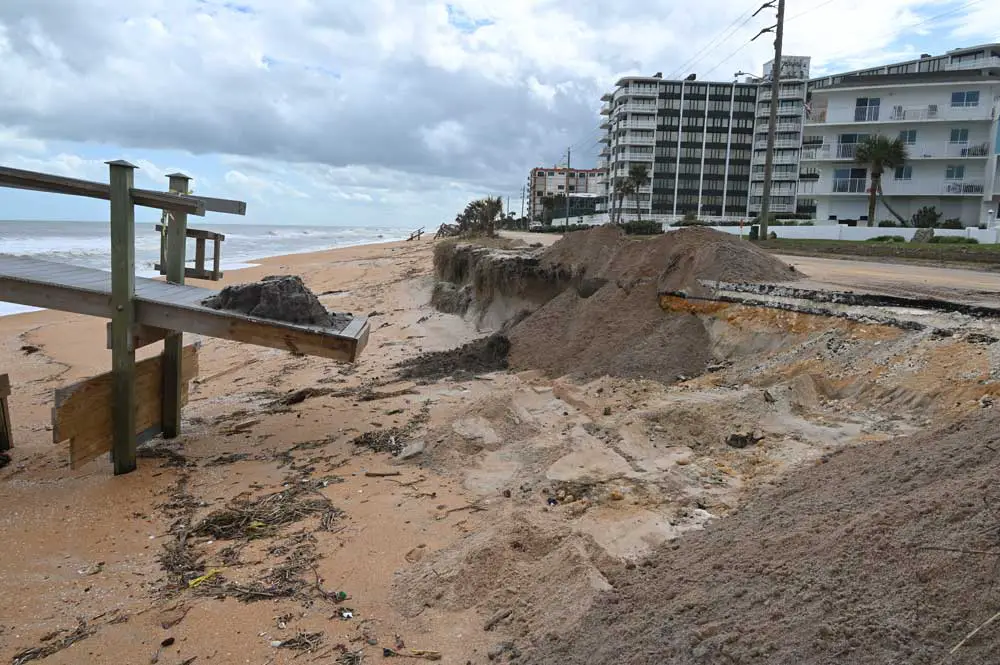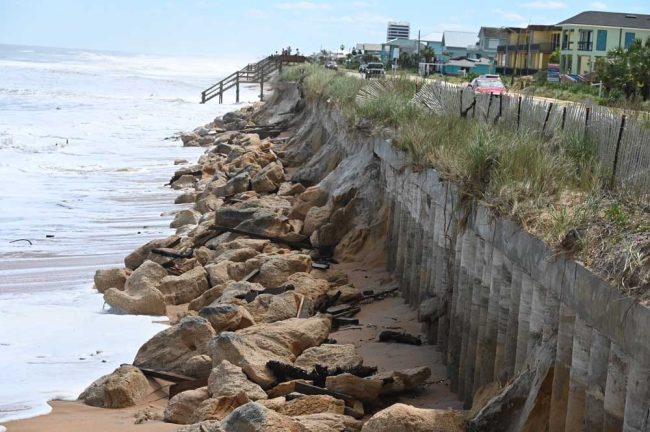
Flagler Beach might as well be known as Construction City for the rest of the year. The second, but nowhere near last, gargantuan project to clang the city began today as the Florida Department of Transportation’s contractors started work on a $24 million, 1.3-mile seawall at the south end of Flagler Beach–what will be the longest sea wall the city has ever known, though it won’t necessarily be visible when completed.
The wall will extend from half a mile north of Highbridge Road in Volusia County to South Central Avenue in Flagler Beach, to Gamble Rogers State Recreation Area, at the foot of the Flagler Beach water tower. The seawall will protect the half dozen condominiums that rise in leviathanic pods from the water tower to the county line–Ocean Beach Club, Nautilus, Ocean View, Costa Del Sol, and so on. The Ocean Palm subdivision rims the city’s nine-hole golf club behind the condos.
The transportation department is building a second 1.3-mile seawall further south, scheduled for construction in summer, from south of Sunrise Avenue to Marlin Drive in Volusia County. The combined cost of the two projects is $115 million.
Construction of the first wall is anticipated to be finished in fall. The second seawall is expected to be completed a year later.
The so-called secant seawall is bulky enough to armor its west side against the sort of chronic erosion that has frequently caused cave-ins along State Road A1A. It will more effectively protect the road than what remaining dunes are in place now. But it will be buried under new dunes as the U.S. Army Corps of Engineers rebuilds the beach in the long-awaited beach renourishment project set to start in July. While the renourishment will extend from north of the Flagler Beach pier to the northern border of Gamble Rogers State Recreation Area, the federal project proper extends from South 6th to South 28th Street, while a “modified” federal project extension will stretch to North 7th Street at the north end, and to Gamble Rogers at the south end. (See explanations and mapping here and here.)
Flagler Beach became familiar with secant wall construction after Hurricane Irma, when the transportation department built the $22 million wall along 4,920 feet of beach from North 18th Street to to Osprey Drive. The wall is a series of 36-inch glass-fiber-reinforced bars that look like pylons that sink 36 feet below the surface. One drawback: seawalls are erosion-friendly.
“The waves hit this fixed structure that creates more erosion at the foot of that wall,” Flagler County Engineer Hamid Tabasssian told WESH 2 News a month ago.

After Hurricane Dorian, the top third of the seawall at the north end of Flagler Beach was laid bare. But it had done its job: A1A was spared. The transportation department eventually reburied the wall in sand. That would be the expected routine if the seawalls at the south end of Flagler Beach and in Volusia County were to be similarly stripped in storms. The transportation department is in the business of building and protecting roads. The beach is not its concern.
That’s where the U.S. Corps of Engineers and local authorities come in, and why the seawalls are intended to work in tandem with the beach renourishment projects. Flagler Beach residents have learned to appreciate seawalls–as long as they do not entirely dominate the shoreline.
For Flagler Beach residents, the seawall construction is adding to construction of the Margaritaville Hotel downtown, and, within months, to the beach reconstruction projects, soon to be followed by the demolition and reconstruction of a concrete Flagler Beach pier.
The transportation department will have a table at Flagler Beach First Friday from 6 to 8 p.m. on -8 p.m. on May 3 to answer questions about the seawall project.
“State Road A1A is a treasured corridor that provides tremendous quality of life and economic vitality to the communities along its length,” said FDOT District Five Secretary John E. Tyler, an engineer. “Our goal through this project was to develop a plan through community partnership and start construction as quickly as possible. At the same time, we have ensured all steps are taken to protect the natural environment.”
Some dune walkovers will be temporarily removed as part of the project. Beachgoers will be able to access the beach from nearby walkovers, and the beach area in front of the walls will be open for public use. The public walkovers across from the water tower, near Gamble Rogers and near Highbridge Road will remain open throughout the project to provide beach access. But residents are reminded to stay off the dunes and be mindful of construction activities.
Walkovers will be replaced as work on each wall section is finished. The project team will coordinate closely with the walkover owners and will limit the amount of time each walkover is closed as much as possible.
The department says in a release that it is adhering to state and federal regulations to protect sea turtles and other wildlife. During sea turtle nesting season, no work can begin until an inspector who is approved by the Florida Fish and Wildlife Conservation Commission inventories the beach for any nesting activity. No work will be done within 10 feet of a nest, and all work will be done during daylight hours.
The contractor is Superior Construction Company Southeast. State and federal infrastructure funds are underwriting the projects.





























Joe D says
Looks like the only way to survive all this construction and disruption of traffic, and beach access, is to close your eyes, grit your teeth, and keep repeating: “This too will pass.”
Eric W Anderson says
pure folly
jim lang says
Waste of money, first strong storm it will be washed away.
Pogo says
@FWIW
https://www.google.com/search?q=2024+ocean+temps+04-22-2024
Peaches McGee says
Every entity has battled Mother Nature, time and time again.
Mother always wins.
Local says
Keep building seawalls. Soon we will have no beaches as the sand will wash away and the water will be all the way up to the seawalls.
TR says
Nice time to be building this sea wall, just before hurricane season starts which means it will be under construction during hurricane season. hopefully a hurricane will not happen in Flagler and take out any construction that has been done. Why not build it before or after hurricane season.
The other thing that doesn’t make sense is the description of the area where the sea wall is being built. the project is 1.3 miles long and yet it states in the article it will will extend from half a mile north of Highbridge Road in Volusia County to South Central Avenue in Flagler Beach, to Gamble Rogers State Recreation Area, at the foot of the Flagler Beach water tower. It’s maybe only half a mile. Guess I’ll have to go take a ride and measure it on my odometer.